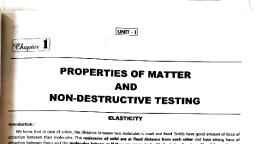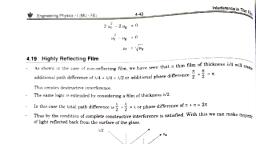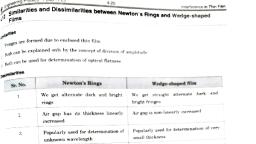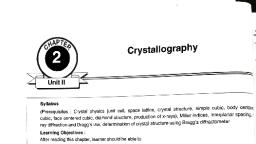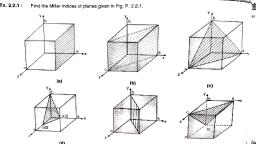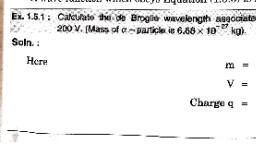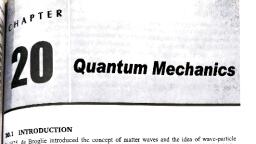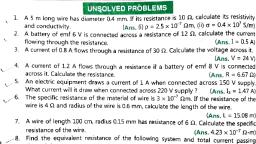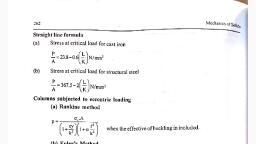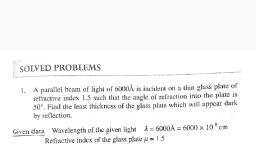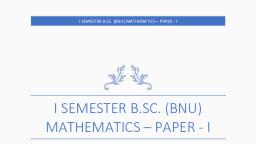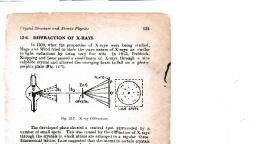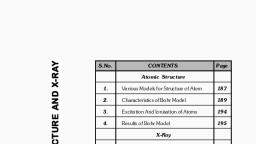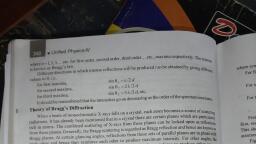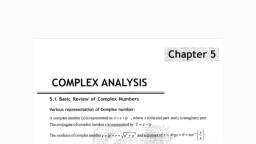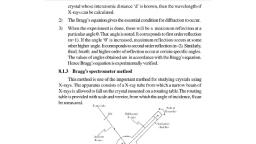Page 1 :
2.6, , Crystallography, , Solved Problems on X-rays, , Ex, 2.6.1, , Calculate the smallest glancing angle at which x-ray of 1.549 A will be reflected, 4.255 Ä. What is the highest order of reflection that can be observed?, , from crystal, , having spacing of, , MU- May 14, 5 Marks, , Soln., na =, , Consider Bragg's law,, , 2 d sin 0, , i) For smallest glancing angle, n = 1, , 0= sin, , =10.488, , Ans., , (ii) For highest order, we know that always, , sin, , 1, , Find n which satisfies this condition using relation, , n, , sin, , 2d, , for, , n = 1,, , sin=, , for, , n = 2,, , sin, , for n =3,, , sin, , for n =4,, , sin 6, , 0.18, =, , 0.36, , 0.54, =, , 0.72, , for, , n = 5,, , sin, , 0.9, , for, , n = 6,, , sin, , 1.087>1, , As sin 6 cannot be greater than 1, the highest order possible is n =5, , Ans., , Other way possible to solve this is by taking maximum sin 0 = 1, n, , =, , 2d, , 2x, 4.255, 1.549 =5.49, , n, , Now n is a fraction, and to convert it into integer remove fractional part., Ex. 2.6.2: Calculate the glancing angle on the plane (100) for a crystal of rock salt(a=2.125 A). Consider the case of 2, order maximum and, , wavelength 0.592 A., MU-Dec. 12, 4Marks, , Soln., ), , Calculate d for rock salt, , d, (ii), , 1.0625 A, , Use Bragg's law for n =2, nA, , =, , 2 d sin 0, , 2 x 0.592 x 10-10 = 2x1.0625 x 10-1x sin, sin e, , 0, , =, , 0.557, , 33.86, , Ans., , echPUDIlC3tions, Kneuledge
Page 2 :
2-25, , F.E.), Physics -I(MU -, , Engineering, , Monochromatic, , Ex. 2.6.3, at what, , angle, , high, , would, , energy x-rays, second, , order, , reflection, , be, , ction is observed at, , crystal., , incident on a, , are, , an, , angle 3, , expected?, , Soln., , n = 1,, , Data:For order, Use Bragg's law, , nl =, for n, , 0,, , 3.4, , 2d sin 0, , =, , 1, , =, , 2 d sin (3.4°), , d, , N2 sin (3.4°), , F o r order n = 2, , 2, , =, , 2d sin 62, , sinsin62, , a, , Replace value of d from equation (1), , sine2, , /2 sin (3.4), =, , 0, , Ex. 2.6.4, , 2 sin 3 . 4 = 0.1186, , sin, , =, , (0.1186), , =, , 6.811°, , ..An=, , The radiation of an x-ray tube operated at 50 KV are ifracted by a cubic KCI, FCC crystal of molecular weig, , 74.6 and density 1.99 x 10 kg/m. Calculate:, Glancing angle for first order reflection from the refilecting planes of the crystal for wavelength, 0.248A"., , Soln., , Given, V= 50x 10 volts, M = 74.6, p= 1.99 x 103 kg/m*,, n= number of atoms/unit cell = 4 (FCC),, , A = 0.248A°, , Step 1:, , Now ap =, , 4x 74.6, V6.023 x 1028 1.99x 103, Since KCl is ionic, , Consider, , 6.29 x 10-0 m, , =, , a/2 .29, =, , crystal,, d, , Step 2:, , =, , x 10-10, , 3.145 x 10-10 mn, , Using Bragg's law, na =, n, , =, , 2 d sin 0, l, , for, , ^ =, , Amin, , Tech Knowl, PubiI atib
Page 3 :
2-26, , Engineering Physics -I(MU-F.E.), , Crystallography, 1x0.248 x 10-10, , 1, , sin, , 2d, , 2, , 0= in, , 3.145x10-10, , x, , 0.0394, , (0.0394) =2.26°, , Ans., , Monochromatic x-rays of wavelength 0.82 A undergo first order Bragg reflection from a crystal of cubic lattice, , Ex. 2.6.5 :, , with lattice constant 3 A, at a glancing angle of 7° 51' 48". ldentify the possible planes which give rise to this, reflection in terms of their Miller indices., , Soln., Data:, , = 0.82 x 10-0 m,, , n = 1,, , 0= 7° 51' 48",, , a = 3x 10-10 m, Use Bragg's law, na =, , 2 d sin 0, , na, , d, , 1x0.82 x10-10, , 2 sin 0 2x sin (7° 51'48", 3x 10-10m, , Now,d, , a, , =, , Here we have d, , h+k+12, , h2+k +12, =, , a, , = 1, , Possible solutions (100), (010), (001) because for all, , h+k+P = 1, , Where,, , Ex.2.6.6, , of them,, Ans., , The glancing angle of reflection for the first order K x-rays from palladium are 5.4° from (100) planes, 7.6°, , from (110) planes and 9.4° from (111) planes. From the above mentioned data determine the cubic lattice structure of the, , crystal., Soln., , Using Braggs law,, n, , =2 d sin 0, , d, , 2 sine, , for (100) ,d,, , or, , 2 sin 5.40.1882, , for (110) ,d2, for, , (n =1), , =, , 2 sin 7.60.2645, , (111) ,d3 2, , sin 9.4, , 0.3266, , ddadg 0.1882 1:0.711 :0.576), d,:d:d:: [1:2 y3]: itis SC, Ex. 2.6.7, , Ans., , Bragg's reflection of the first order was observed at 21.7° for parallel planes for a crystal under test. If the, , wavelength of x-rays used is 1.54, , the lattice constant of the crystal., , Soln., n, , =, , 1,, , =, , 21.7° (Assume it is glancing angle), , TechKnewledye, PudIICations
Page 4 :
Engineering FiysicS, , A = 1.54 Á,, na, , =, , a, , 2dsin6, , n a 1x 1.54 x 10-10, , 2, , sin6 2x sin (21.7°), , 2.083x 10-10 m, , d = 2.083 A, , Ans, Ex. 2.6.8, , Calculate the glancing angle on the cube (100) of a rock salt (a = 2.814 A) corresponding 2d order diffracti, o, , maximum for x-rays of wavelength 0.714 A., Soin., , 2.814, , a, , Vh+k +?1240+02.814 A, For 2nd order Bragg reflection, na =, , 2dsine, , 20.714)= 2(2.814) sin6, , sine=, , 0.2537, , 0, , =, , 14° 41', .Ans., , Ex. 2.6.9, , The, , spacing between, , the, , reflection occurs at 10°., , (a), , What is the, , (b), , At what, , principal planes, , in, , a, , crystal, , of NaCi is 2.82 A. It is found, that first order, , Braggs, , wavelength of x-ray?, , angle does the, , second order reflection occur?, , (c) What is the highest order of reflection seen?, Soln., Given: d = 2.82 x 1010, m, n= 1, 0, , =, , 10°, , (a), , nA =, , 2dsine, , a, , 2(2.82, , =, , =, , A, , b), , =, , 9.79, , x, , x, , 10-10) (sin 10°), , 10-11, , mn, , 0.979 Å, Ans, , For n = 2 find 0, , Using, , na =, , .2x (0.979x 10-10), sin, , (c) For, highest order, , 0, , sine, , 20° 18', Ans, , sine, , As sine cannot, for various, , The value of n, which yields, , 2(2.82 x 10-10), , 6 = 0.347, , na =, , exceed one,, values ofn ie. n, , 2dsine, , =, , 1, 2, 3,.. find sine., , 2dsine, 2d
Page 5 :
Engineering, , 2-28, , Physics I(MU - F.E.), , Crystallography, , sin6> 1 is not possible., here for n = 6, , we get,, , sine, , 1.041, , i.e. sin6>1, Highest order possible is 5., Ex.26.10, , Ans., , In comparing the wavelengths of two monochromatic x-ray lines, it is found that line A gives a 1 order Bragg, refiection maximum at a glancing angle of 30° to the smooth face of a crystal. Line B of known wavelength of, , 0.97 A gives a 3 order refilection maximum at a glancing angle of 60° with the same face of the same crystal., Find the wavelength of the line A., , Soln., For line, , Aorder, , n = 1, , 8 30°, =?, Using Bragg's law for line - A, , n, , =, , 2dsine, , 1A 2dsin30 = 2d = d, , ...1), For line, , B, , a = 0.97 An=3, , 60 d=^A, na, , =, , 2dsine, , 3(0.97) = 2a) sin 60°, , 3(0.97) 20), , 3x0.91.68, A, V3, Ex 2.6.11:, , Ans., , metal for which atomic, A 10 keV electrons are passed through a thin film of a, minimum?, difraction, the angle of deviation of the first order, , spacing, , is 5.5, , x, , 10", , m., , What is, , Soln., (1), , Energy = 10 keV= 10 x 10*x 1.6 x 1019 J, , h, , 2mE, 6.63 x 10-, , V2 x, , 34, , 9.1x 10-x 10x, , =, , 1.23 x 10-, , =, , 2d sin6, , 1.6 x 10-19, , m, , Using Bragg's law (forn = 1), n, , 1x1.23 x10= 0.118, , sin, , 2x5.5 x10*, , 0, , 6.42°, , ..Ans., TechKnomledge, Pubilcations
Page 6 :
Ex.2.6.12:, , Calculate the, , glancing angle, , on, , cube, , of rock salt, , (100), , having lattice, , constant 2.814, , A Corresnondina, , ., , of wavelength 1.541 A., order diffraction maximum for x-rays, , Soln., Given:, , Plane (100), , a, , = 2.814 A 2.814x 10-10m, , =, , 1.541A =1.541x 1010 m, , n, , =, , 1, , na, , =, , 2d sin 0, , Bragg's law,, For rock salt, , 1.407 x10-10m, , d, , .0, , sin"| 2d,, 1x 1.541 x 10-10, , sin, sin-, , 2 x 1.407x 10-10, , (0.5476) =33.20, , An, , Ex. 2.6.13: Calculate the maximum order of diffraction if x-rays of wavelength 0.819 A are incident on a crystal of latice, spacing 0.282 nm., , MU -Dec. 13, 4 Marks, , Soln., , Given: =0.819 A , d=0.282 nm, Formulae:, n=2d sin 6, for the given values of A and d, na sin 6, for n to be maximum, sin 6 = 1, , 2x0.282 x10-, , n, , A s order, , 0.819x 10-106.88, , cannot be a fraction andnis maximum,, n, , Ex. 2.6.14:, , 63, , Calculate Bragg angle if (200) planes of a BCC, reflection with X-rays of wavelength 0.71 A., , Soin., Given:, , .Ans, , crystal, , with lattice, , parameter, , 2.814 A, , give second orde, , MU-Dec. 14, 4Marks, a, , =, , 2.814, , (hkl) =, , (200), , .d, , =, , a, , h+k+/, 2.814, , 23+0 +0, =, , 1.407A, , Using Bragg's law, n = 2d sine, Tec, , ublica, , ion
Page 7 :
2-30, , Engineering Physics I(MU -F.E.), , 2x0.71 =, , 0.71, 1.407, , sin, , 0, , Crystallography, , 2x 1.407 x sine, , 0.5046, , 30.30°, , Ans., , Ex. 2.6.15:X-rays of unknown wavelength give first order Bragg's reflection at glancing angle 20° with (212) planes of copper, having FCC structure. Find wavelength of x-rays H the lattice constant for copper is 3.615 A., , MU- May 15,7Marks, Soln., a, , d, , Using formula, , h2+k2+2, 3.615, , A, , 22+12 +22, 1.205 A, , Using Bragg's law, nA, , =, , 2 d sine, , n, , =, , 1, , Here, , 20°, 1x =, , =, , 2x 1.205 x sin 20, , 0.824 A, , .Ans., , Ex 2.6.16: Monochromatic x-ray beam of wavelength à = 5.8189 A is reflected strongly for a glancing angle of, , 6, , 75.86 in first order by certain planes of cubic of lattice constant 3A°. Determine Miller indices of the, , MU-May 16,3Markss, , possible refiecting planes., Soln., , Problem:, i5.8189A , 6 = 75.86,, , n = 1, a= 3 A, n, , as, , =, d, , =, , a, , =, , d, , d, , Possible planes, Ex. 2.6.17, , (1, , 00),, , 2 d sin 6, , nA, 2 sin 6, 3A°, , 3A°, , (given), , Vh+k+P, =, , a, , (010), (00 1), , Ans., , An electron is accelerated through 1200 volts and is reflected from a crystal. The second order reflection occurs, when glancing angle is 60. Calculate the interplanar spacing of the crystal., , MU-May 17, 8 Marks, , Soln., , Data: V = 1200 volt, order n = 2,, glancing angle = 60°, To, , find:, , Interplanar spacing d., Tech, , Keeuledge, , PDICIt0ns

